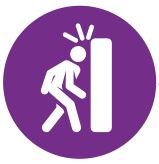Behaviour Change Techniques
In this page you will find a selection of behaviour change techniques used in our research and consultancy activities.

GOALS AND PLANNING
Setting goals for a specific target behaviour, and highlighting what it will allow to achieve, holds a major potential for behaviour change interventions. This techniques involve anticipating what barriers and constraints might make it more difficult to complete the target behaviour, planning what can be done to overcome the barriers, and developing very specific plans about how the target behaviour can be completed.
Goal-setting (behaviour) - Set or agree a goal defined in terms of the behaviour to be achieved.
Problem-solving - Help or encourage the client to reflect on factors influencing the target behaviour and generate or select solutions and strategies to help them achieve it.
Goal-setting (outcome) - Set or agree on a goal defined in terms of a positive outcome of the wanted behaviour.
Application Example: Drivers in a hurry may feel that bicycle in their way are preventing them to reach the destination on time thus rapidly overtaking and passing them too close. In order not to commit aggressive driving toward cyclists they could revise the schedule and foresee longer travel time on routes where bicycle are present. Positive outcomes should be highlighted (less stress while driving, less risk of having an accident).

FEEDBACK AND MONITORING
These techniques, often complemetary to goal setting techniques, are concerned with monitoring progress towards the goals, and giving people feedback about how well they are doing. This covers the client monitoring their own behaviour and its outcomes, somebody else monitoring it, and the person receiving feedback.
Feedback on behaviour - Monitor or observe the behaviour and give informative or evaluative feedback on performance of the behaviour (e.g. form, frequency, duration, intensity).
Self-monitoring of behaviour - Establish a method for the person to monitor and record their behaviour(s).
Feedback on the outcomes of behaviour - Monitor and provide feedback on the outcome of the behaviour.
Application Example: In order to reduce too close following behaviours by drivers, it is possible to watch them driving and give feedback about their distance from the preceding vehicle. Sensor could be mounted in the front side of the vehicle to monitor too close following events and an interface could provide feeds back on how they are doing using green, amber and red LEDs.

SOCIAL SUPPORT
This set of techniques cover providing social support, for example from friends, family, colleagues or professionals. This support can be unspecified, practical or emotional.
Social support (unspecified) - Advise on, arrange or provide social support (e.g. from friends, relatives, colleagues) or encouragement for performing the behaviour.
Social support (practical) - Advise on, arrange, or provide practical help (e.g. from friends, relatives, colleagues) for performing the behaviour.
Social support (emotional) - Advise on, arrange, or provide emotional social support (e.g. from friends, relatives, colleagues) for performing the behaviour.
Application example: Techniques based on social support holds great potential to prevent people from drink-driving. People could be advised to ask their friends to help them not to drink-drive by not offering them an alcoholic drink when they are meeting in the pub or agreeing a rotation for a designated driver.

SHAPING KNOWLEDGE
In order to change some kind of behavior, it is of utmost importance to help people in gaining a better understanding of what causes them to behave in a certain way, and in actually knowing how to perform the target behaviour.
Information about antecedents - Provide information about things that trigger the behaviour. This can include events, situation, thoughts and feelings.
Instruction on how to perform a behaviour - Advise or agree on how to perform the behaviour.
Re-attribution - Get clients to review what they think causes their behaviour and suggest alternative explanations.
Application example: In order to prevent distracted cycling and particularly the use of smartphone while riding a bike, it is useful to help cyclists identify what causes them to use the smartphone while cycling, such as felling bored, using the time spent riding to send important messages or make calls, loving the feeling of riding and listening to the music. The person could be then advised to think at other possible explanations and find a strategy to prevent himself to use the smartphone while riding.

NATURAL CONSEQUENCES
These techniques are about highlighting the consequences of performing the behaviour, including the social, environmental and emotional consequences, making
these consequences seem more real to clients, and making them realise that they would regret failing to change their target behaviour.
Information about consequences - Provide information (e.g. written, verbal, visual) about the consequences of performing the behaviour. This can be for self or others.
Salience of consequences - Make the consequences seem more real or memorable to the individual.
Anticipated regret - Get the person to imagine how regretful they would feel if they perform the unwanted behaviour and something negative happens.
Application example: Cyclists dooring is a frequent and dangerous type of accident. Through behaviour change techniques, drivers could be prompted to be more careful when opening car door. For example, Showing a video of a driver hurting a cyclist because of a dooring accident and get the person to imagine to be the driver, anticipating what feelings he could experience. Ask the driver to imagine how they will feel if they door a cyclist while rushing out of the car, without scanning the proximity of the vehicle. To increase the anticipated regret it is possible to report detailed information on the injuries suffered by the cyclists and negative consequences due to the accident.